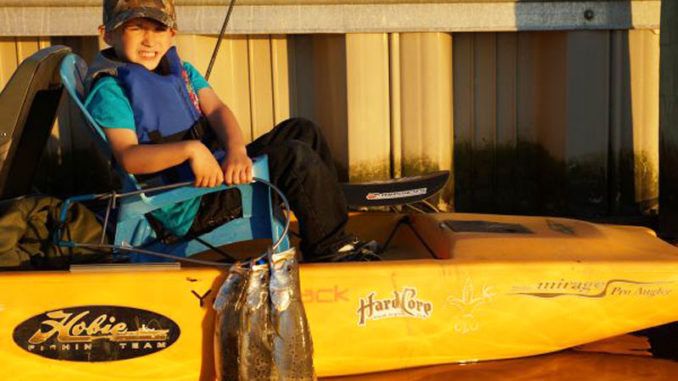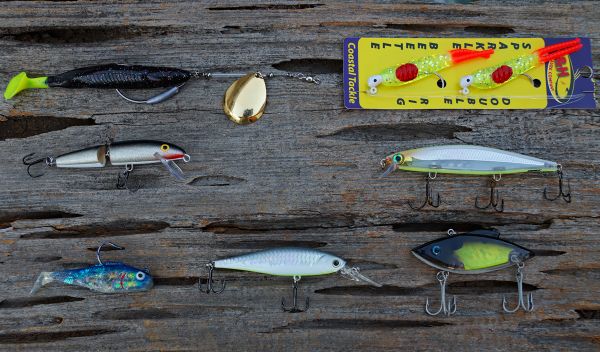
You’re slowly making your way across a small lake. Suddenly, both lines dragging behind the kayak go tight.
It’s a problem, but a good problem.
Following a bit of combined excitement and confusion, you manage to reel in two nice speckled trout.
If you give kayak trolling a try, you’ll find this often -underutilized method can be quite productive.
Trolling is not a widely practiced method of catching speckled trout in Louisiana. However, a few dedicated anglers use the method to drag their baits along the bridges in Lake Pontchartrain and a couple other areas.
The long, straight lines of the pilings provide a highway of structure which is targeted mostly by power-boaters, usually in the early spring. However, speckled trout can be caught trolling nearly anywhere and at all times of the year.
And kayaks make excellent platforms to troll for trout. They are quiet, and normal pedaling or paddling speed is usually perfect for a wide variety of lure presentations.
Be it a bridge, canal, lake or lagoon, trout can easily be picked off while trolling a selection of lures. Nearly any lure you can cast and retrieve can be used as a trolling lure.
Set up
The first order of business is to set up the kayak. Nothing fancy is needed. One or two extended rod holders keep your rods secure while trolling along.
The holders that can be angled to various positions are best. Set the rod holder to point your rod outward and slightly forward to keep the lines separated and cover a wider swath of water as you move along.
A long rod leash keeps the rod tethered to the kayak and safe from loss.
Trolling no more than two baits at once is optimal. The majority of time you will get a single strike, but sometimes both rods will get bit at nearly the same time.
When this happens, there are techniques to successfully land both fish.
Rod placement
If you have a pedal kayak, it’s best to leave one rod in the holder and continue to slowly move forward while landing the other.
If you are paddling, it’s a bit more difficult, but do your best to maintain tension on the rod in the holder while fighting the first fish. This can be done by sneaking in a few one-handed paddle strokes or a few quick turns of the reel.
In either case, get the first fish in the kayak and leave it hooked and turn your attention to the second fish.
You can troll with both rods in the holders, but placing one in the holder and keeping one in your hand has some advantages. Doing so allows you to impart additional action with one rod by pulling the bait forward and letting it drop back or slightly twitching it now and then. Sometimes this change from simply pulling the baits behind you will draw strikes.
While it is possible to troll more than two lines at once, it usually leads to tangled lines and lost fish.
Two lines are easy to manage and doubles your chances of getting a strike.
Lures
One of the simplest and most-effective trolling lures is a Sparkle Beetle or other soft plastic tail on a jighead. Double beetles work great, and the trailing lure is often bit by fish that may pass at striking when the first swims by but react when they see the second one a split second later.
Of course, there is always the possibility of a double strike if you troll through a school of competitive fish.

While speed can control the depth of the trolling presentation, it’s much easier to do so by choice of lure style, weight and distance behind the kayak.
Certainly you can move faster or slower, but it’s not practical to maintain a quick pace for long periods of time. Just paddle/pedal at your normal, comfortable speed and adjust the other factors accordingly.
Heavier jigs run at deeper depths. In shallow lagoons and bays, bouncing the jig along the bottom draws strikes from hungry trout.
Treble hooked-lures are difficult to troll in shallow areas unless you use a floating, lipped crankbait-type lure. Use one with a small bill so it doesn’t dive too deep and will float to the surface if you stop moving for any reason.
For deeper areas, lipless crankbaits like a Rat-L-Trap or sinking/suspending lipped baits work well. They give off vibration and flash as they are trolled along. Larger, lipped lures dive deeper. Sinking lures or those with larger lips run deeper still.
Line
No matter the type of lure used, however, the amount of line you let out helps determine the depth at which the lure will swim.
Letting out more line causes the lures to run deeper. If you are trolling two lures at ones, vary the line distances until you find which is most productive.
Trolling grassy areas is difficult with exposed-hook lures, especially those with treble hooks.
But don’t bypass these areas. Instead, tie on an in-line spinner bait with the plastic tail hooked weedless. The slim profile of the bait goes through the grass with no exposed hook to get snagged. The spinners turn easily, even at kayak trolling speeds.
A depth finder
While not a necessity, a depth finder can be an invaluable tool to increase your trolling success. The screen shows the depth of the water, but also reveals bait, fish, and the structure and contour of the bottom. Watching the screen as you troll along gives clues to where the fish are holding.
Make mental notes when a strike occurs so you can duplicate the success by trolling across similar areas.
Trolling is also a great way to introduce children to kayak fishing. They don’t have to be proficient at casting or working a lure. If they can hold onto the rod, they can catch fish. Tandem kayaks are great for taking children along. However, many of the larger, single-seat, models have room in the front or back to add a small seat or chair that’s perfect for a child. Be sure they wear an appropriately sized PFD.
So give kayak trolling a try and you’ll be pleasantly surprised at the number of speckled trout you can drag into your kayak.


